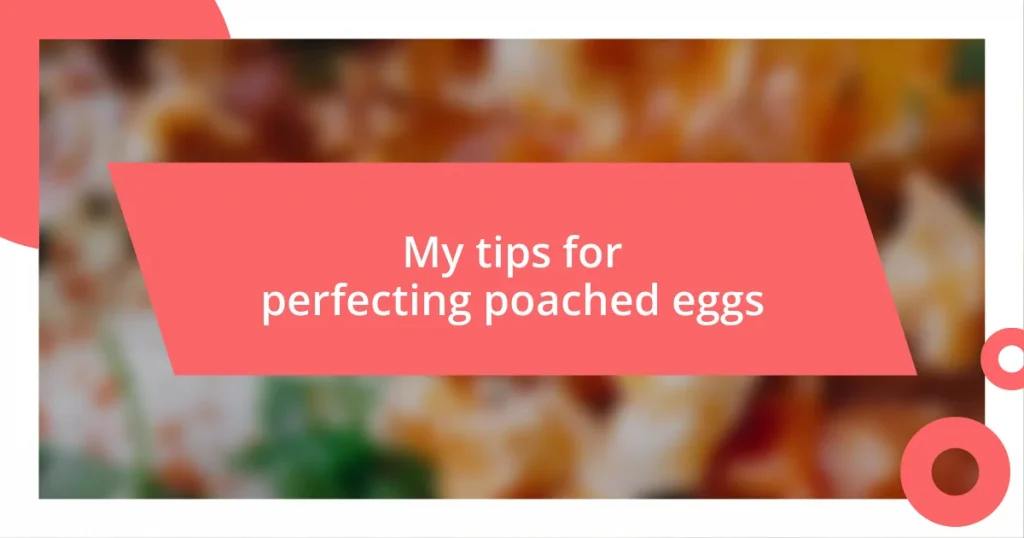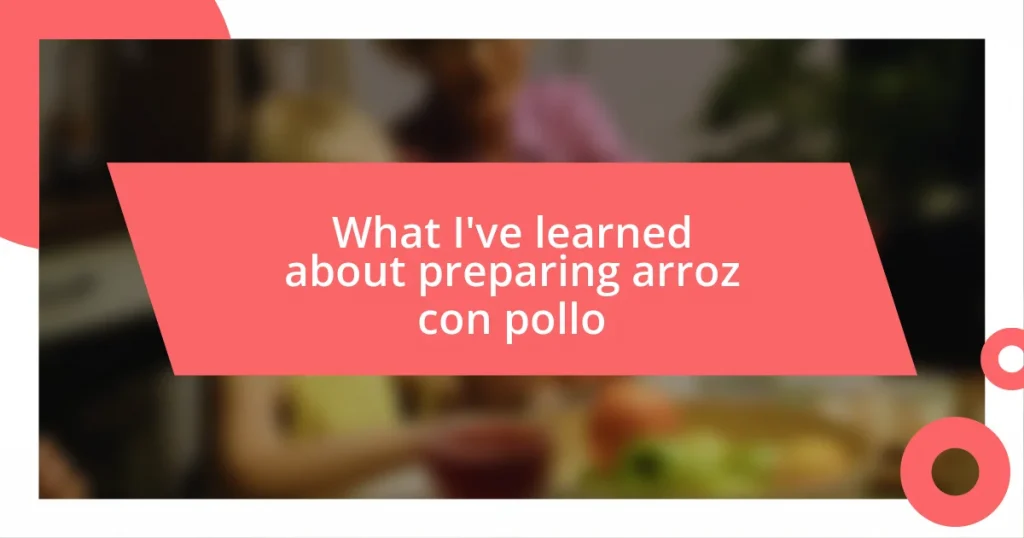Key takeaways:
- Fresh, high-quality eggs and proper water temperature (180°F to 190°F) are crucial for achieving perfectly poached eggs.
- Timing is essential; typically, 3-4 minutes results in the desired runny yolk consistency.
- Presentation matters; serving on warm plates with flavorful seasonings and garnishes enhances the overall experience.
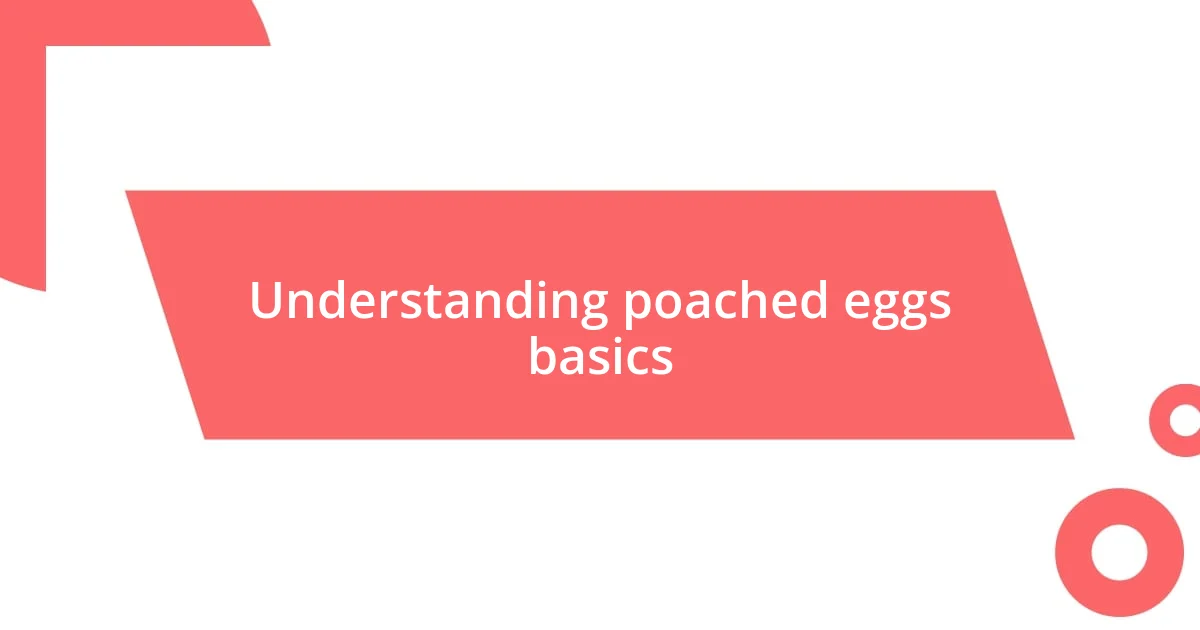
Understanding poached eggs basics
Poached eggs are a cooking technique that creates tender, delicate eggs without the use of fat, which is a health-conscious alternative to frying. The magic happens when you introduce fresh eggs into gently simmering water, which results in that beautifully runny yolk I know so many people crave. I often find myself wondering, what is it about that perfectly poached egg that can turn a simple breakfast into something extraordinary?
Understanding the basics isn’t just about technique; it also involves choosing the right eggs. Freshness plays a huge role; I’ve noticed that the fresher the egg, the better it holds its shape in the water. Have you ever experienced a poached egg that just fell apart? It’s disappointing, right? The thrill of a clean, intact poached egg really does elevate the whole dish.
Another important aspect is water temperature. I’ve learned that a gentle simmer, around 180°F (82°C), is key. Too vigorous of a boil can turn your egg into a shapeless mass, which can be frustrating when you’re aiming for that Instagram-worthy brunch. Remember, patience is your ally in this process; taking a moment to understand these nuances can lead to that perfect poached egg experience.
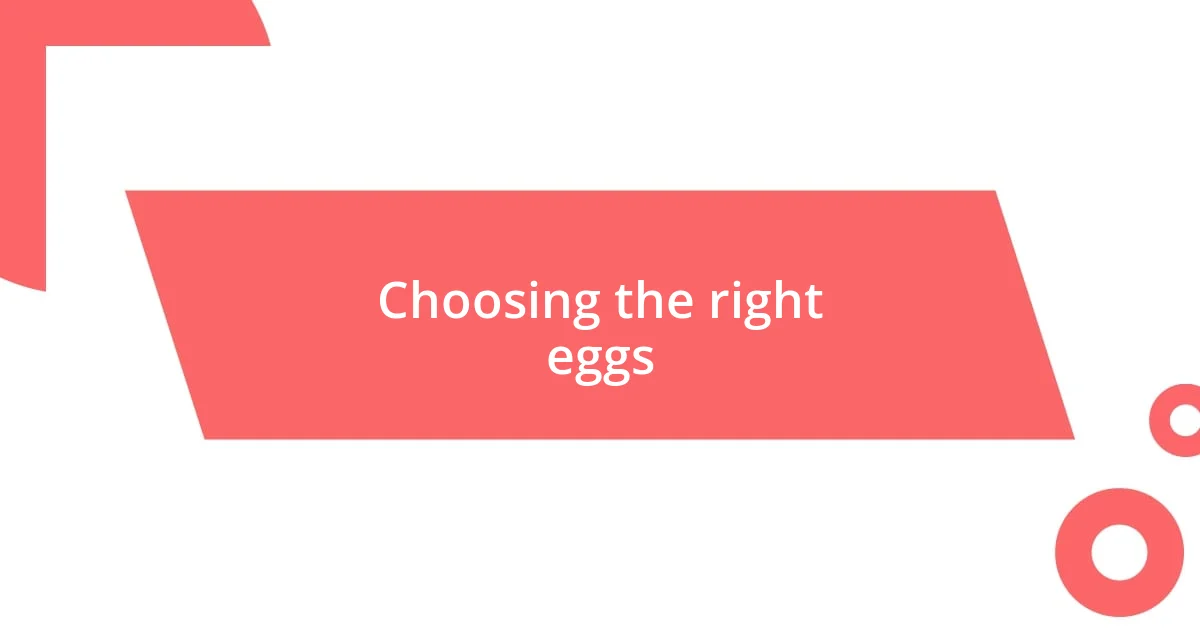
Choosing the right eggs
When it comes to selecting eggs, your choice can truly make a difference. I’ve often found that organic, pasture-raised eggs not only taste better but also have a vibrant yolk that enhances the visual appeal of my poached eggs. There’s something satisfying about knowing that the eggs I’m using come from healthy hens, roaming freely and enjoying a natural diet. It’s almost like the quality of the egg brings a little extra love to the plate.
Consider these factors when choosing eggs:
- Freshness: Look for eggs with a recent expiration date. Fresh eggs result in better poaching.
- Quality: Opt for organic, free-range, or pasture-raised eggs whenever possible. They generally taste better and have richer yolks.
- Size: Medium to large eggs tend to poach more effectively than smaller sizes, as they maintain their shape well during cooking.
- Color: While the shell color doesn’t affect the taste, I often find brown egg yolks to be slightly richer, making the dish more visually appealing.
I remember trying different eggs and being amazed at the difference in flavor. Each time I experimented, it felt like I was unlocking a secret to the perfect poached egg. Choosing the right eggs is truly the first step to creating something special.
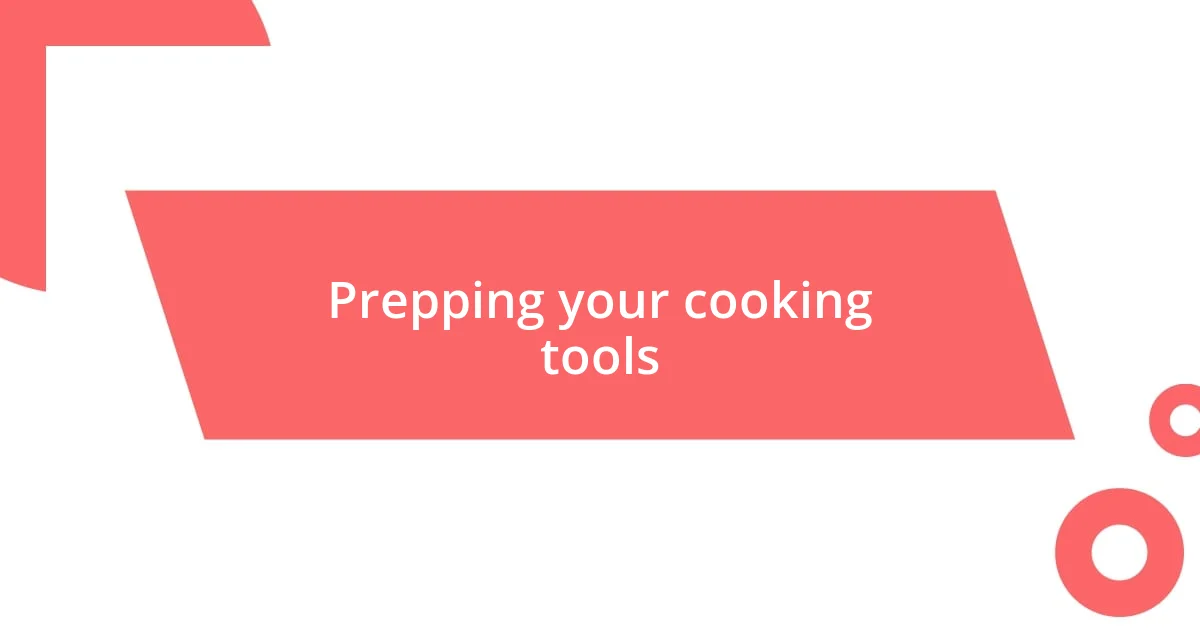
Prepping your cooking tools
When it comes to poaching eggs, having the right tools can make all the difference. In my experience, a sturdy saucepan or pot with a wide, flat bottom is essential. This allows water to circulate evenly around the eggs. I once tried using a small, narrow pot, and it felt like a struggle. The eggs ended up sticking together, and that was definitely not the serene cooking experience I was hoping for!
Another important tool is a slotted spoon. I can’t stress enough how handy this tool is for both lowering the eggs into the water gently and retrieving them once they’re perfectly poached. Without it, you’d be left trying to fish the eggs out with a regular spoon, which can easily lead to mess and frustration. It’s funny how such a simple tool can bring such peace of mind during the cooking process.
Lastly, don’t forget about a timer. I’ve learned the hard way that timing is crucial. I often set a timer for three to four minutes depending on how runny I want the yolk. When I forget to time it, my eggs sometimes turn out either too runny or overcooked. Trust me, there’s nothing more disappointing than biting into what you hope will be a beautifully poached egg, only to find a rubbery yolk instead.
| Tool | Purpose |
|---|---|
| Sturdy Saucepan | Allows for even water circulation and prevents sticking |
| Slotted Spoon | Helps gently lower and retrieve eggs from water |
| Timer | Ensures perfect cooking time to achieve desired yolk consistency |
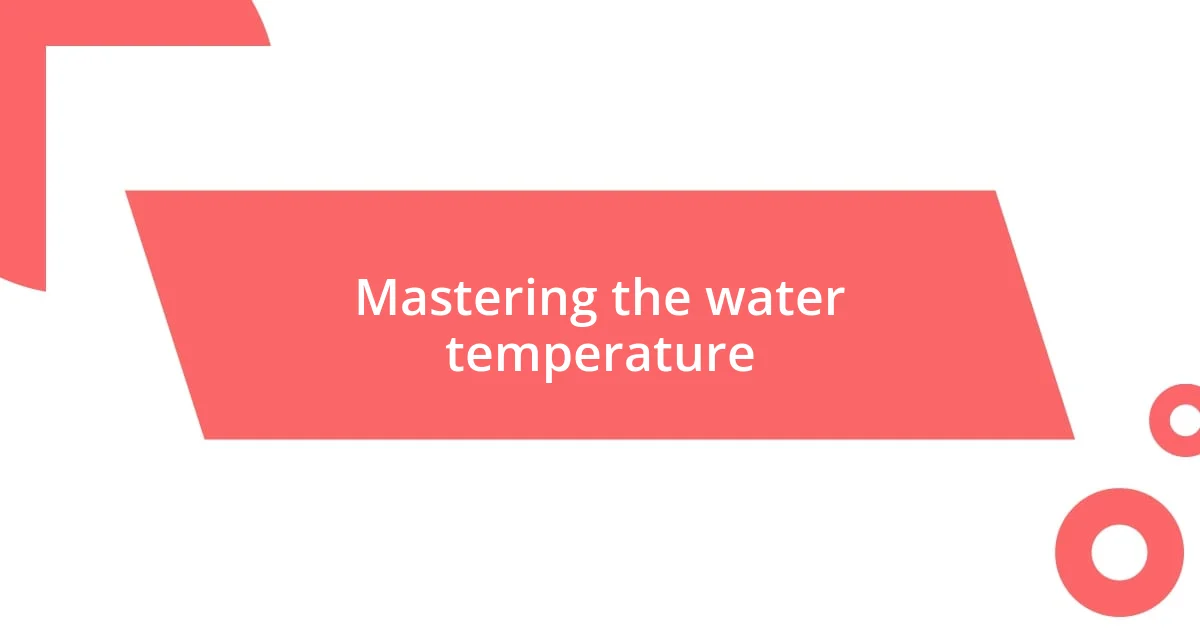
Mastering the water temperature
When it comes to the water temperature for poaching eggs, it’s crucial to find that sweet spot. I’ve found that water should ideally be just below a simmer, around 180°F to 190°F (82°C to 88°C). Too hot, and the eggs can turn into a chaotic mess; too cool, and they won’t hold their shape. Have you ever watched an egg slip into boiling water, only to witness it turn into a feathery cloud instead of a cohesive poached delight? I’ve definitely been there!
Maintaining that perfect temperature isn’t just about paying attention; it’s also about feeling confident in your process. I’ve noticed that using a thermometer helps, but sometimes, I trust my instincts more. The moment I see gentle bubbles forming—without roaring into a boil—I know I’m just where I need to be. It’s fascinating how such a small adjustment in temperature can dramatically change the outcome.
In my experience, patience is key. Allowing the water to come to the right temperature can be the difference between a heartbreaking disappointment and a beautifully poached egg that makes your breakfast moment truly special. So, next time you get ready to poach, take a deep breath, feel that anticipation building, and trust that your careful attention to water temperature will pay off. Isn’t it rewarding to create something that looks as good as it tastes?
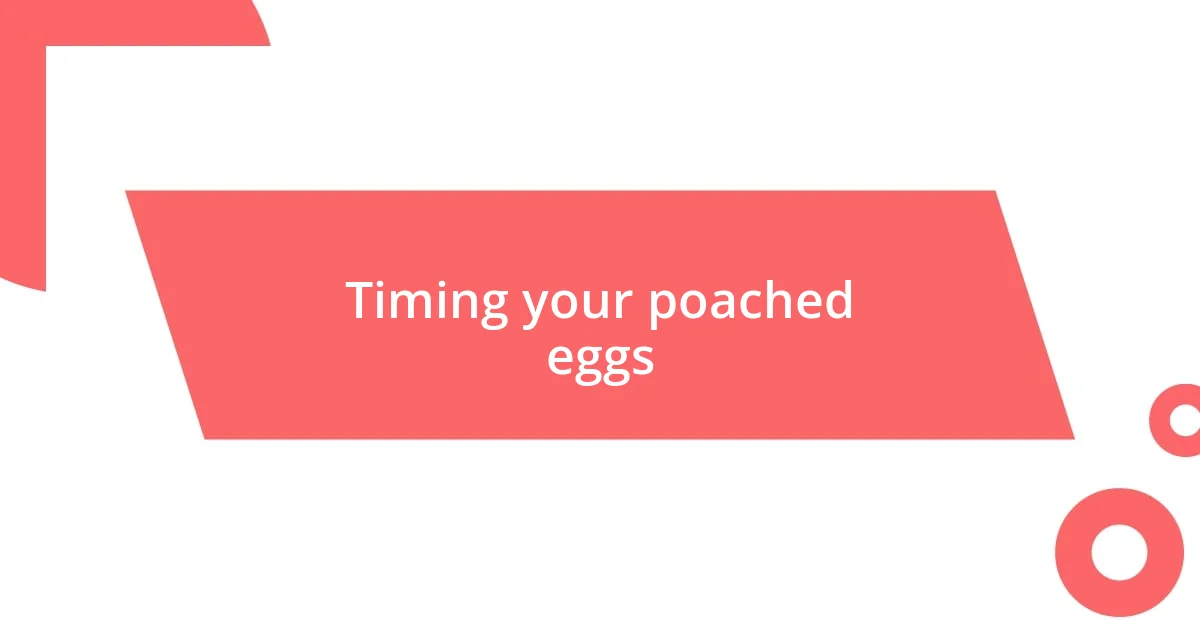
Timing your poached eggs
Getting the timing just right for poached eggs can make the difference between a perfect breakfast and a culinary disappointment. I personally set my timer for exactly three minutes for a classic soft poached egg with a runny yolk. It’s that magical moment where you can almost feel the anticipation as the timer counts down. If you keep a close eye on it, the reward of slicing into that egg to reveal the golden yolk makes it all worthwhile!
It’s interesting how many variables there are when poaching eggs. One time, I got caught up in a conversation and pushed my poaching time to four minutes. The result was an egg that, while not inedible, lacked that silky texture I love. I learned that losing focus, even for a moment, can alter the outcome. So I ask myself: how badly do I want that perfect egg? Each time I perfect the timing, I feel a sense of mastery over something that initially felt so challenging.
In the kitchen, timing often feels like an art more than a science. I often find myself thinking, “Am I hitting the sweet spot?” I’ll peek into the pot near the end of my set time, watching for the subtle changes as those whites become opaque. There’s a satisfying joy in this attentive ritual—just remembering to be present and engaged makes a huge difference. Have you experienced that little thrill when you see everything coming together just right? That’s what keeps me coming back for more poached egg adventures!
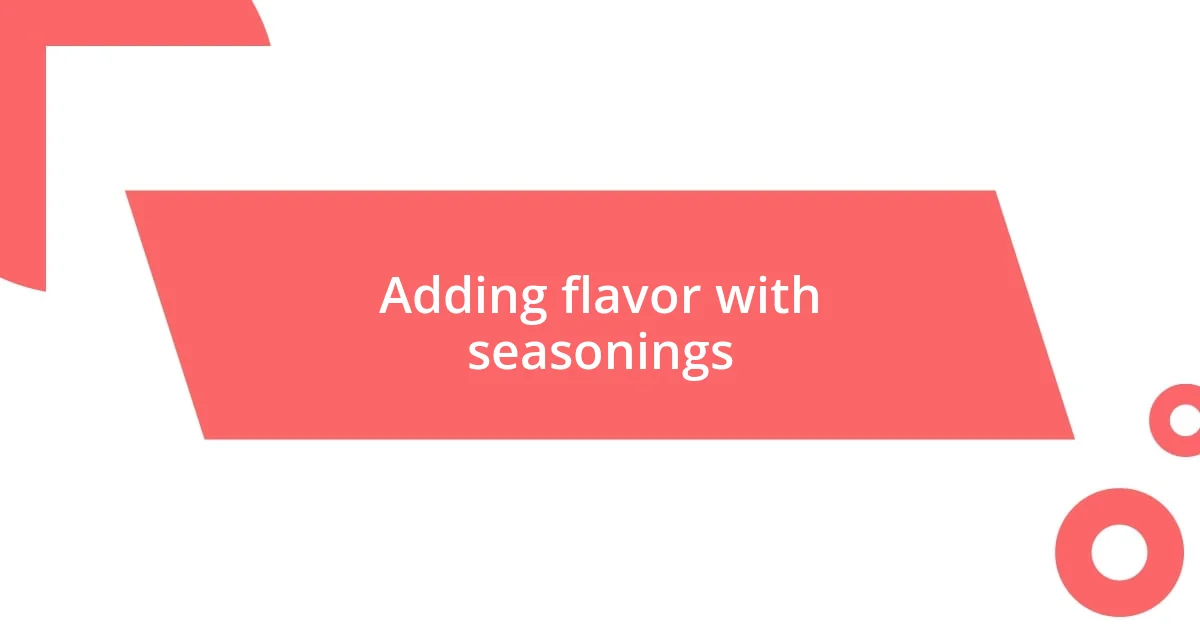
Adding flavor with seasonings
When it comes to adding flavor with seasonings to poached eggs, I’ve often found that a pinch of salt can work wonders. The difference is palpable; just a dash elevates the taste, enhancing that creaminess of the yolk dramatically. I remember once, in a quest for gourmet flair, I experimented with smoked paprika, and it was like a flavor revelation! Who knew a sprinke could transform a simple egg into a savory masterpiece?
Herbs are another fantastic way to infuse flavors. I love tossing in freshly chopped chives or parsley while they poach. There’s something almost meditative about the way their aromas fill the kitchen, wrapping your meal in a fragrant embrace. Have you ever tried adding fresh dill or even tarragon? The unique twists they bring make every bite feel like a culinary adventure, reminding me why I started cooking in the first place.
If you’re feeling a bit adventurous, why not try a splash of a flavorful vinegar? I’ve had some fantastic results with a hint of white wine vinegar, which not only helps keep the eggs intact but also adds a subtle tanginess that pairs beautifully with the richness of the yolk. It’s those unexpected combinations that ignite my passion for cooking. What have you discovered on your journey of flavor exploration?
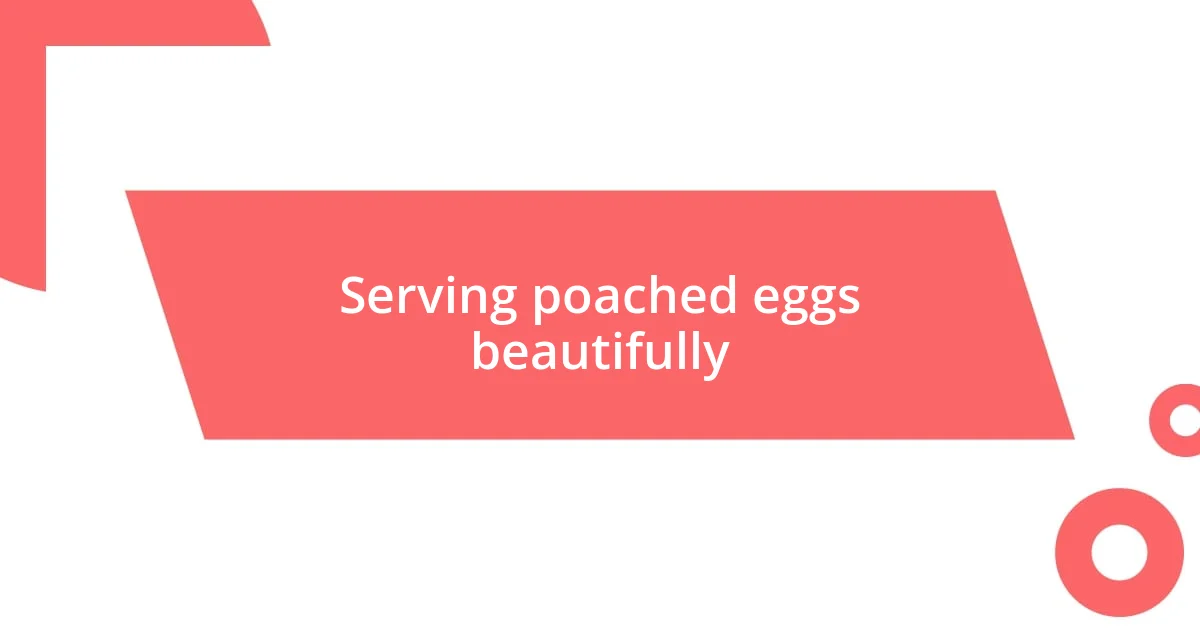
Serving poached eggs beautifully
When serving poached eggs beautifully, presentation can elevate the entire experience. I always try to use a neutral-colored plate to make those vibrant, runny yolks stand out. I remember one brunch where I served my perfectly poached eggs atop a slice of avocado toast, garnished with a sprinkle of microgreens. The burst of color added life to the dish, making it not just visually appealing but also Instagram-worthy!
An essential aspect of serving poached eggs is the right temperature. Have you ever taken a beautiful dish to the table only to have the eggs cool off too quickly? I learned the hard way that serving them on a warm plate keeps the poached eggs inviting and enjoyable right up to the last bite. A simple trick like pre-heating the plate can make a difference. It’s about treating your guests to an experience rather than just a meal.
Lastly, don’t forget to add a drizzle of sauce or a scattering of herbs right before serving. A few drops of hollandaise can turn a humble poached egg into an elegant delight. I recall the joy I felt the first time I topped my eggs with a homemade herb-infused oil. It’s those little touches that show you care, and they spark conversations around the table—what will you try next time?










